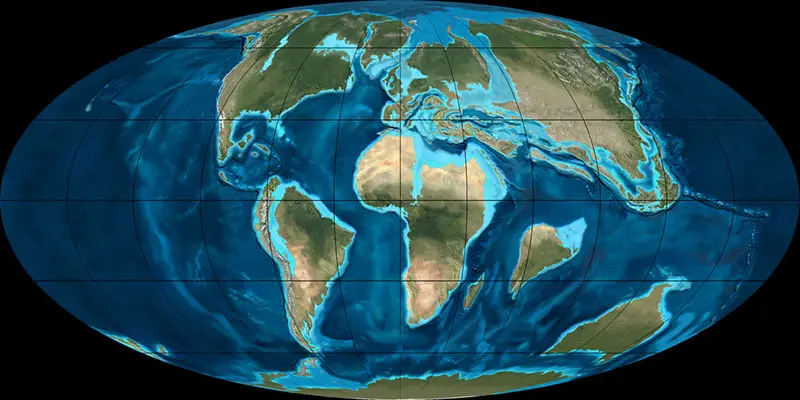†Arctodontomys (Microsyopidae)
Arctodontomys ist eine Primatengattung innerhalb der Familie Microsyopidae, deren 4 Mitglieder ab dem frühen Paläozän lebten, das vor ungefähr 56,0 Millionen Jahren begann und bis vor vor 33,9 Millionen Jahren andauerte. Viele Überreste wurden in Vereinigte Staaten von Amerika (USA) gefunden.
Arctodontomys ist der Gattungsname von drei ausgestorbenen Primaten aus der Unterfamilie Microsyopinae innerhalb der Familie Microsyopidae. Sie lebten vom späten Paläozän bis ins frühe Eozän in Nordamerika.
Arctodontomys nuptus
Arctodontomys nuptus war ein baumlebender Allesfresser (Omnivore). Aus den Abmessungen seiner Backenzähne kann man auf sein Körpergewicht schließen: 784,5 Gramm.
Arctodontomys simplicidens
Arctodontomys simplicidens war ein baumlebender Allesfresser. Basierend auf der Größe und Morphologie der Backenzähne von Arctodontomys simplicidens schätzt man sein Körpergewicht auf 567,9 Gramm.
| Sammlung | Kommentar zum Fundort | Epoche, Alter | Geologie, Formation | Kommentar zur Sammlung |
|---|---|---|---|---|
| Big Multi Locality | Fort Union | Big Multi Quarry; CM 2433; UCMP V-76134; ETE Locality 1563 | ||
| Kommentar z. Stratigraphie | Lithographie | Kommentar z. Taxonomie | ||
| "75-100 m below the base of the Wasatch Fm." | ETE rock type adj: "prple,gry,blcky" | work of Krause 1980 appears to postdate that of Rose |
| Physiologie | |
|---|---|
| Gewicht: | ? |
| Schwestertaxa | |
Arctodontomys wilsoni
Das Typusexemplar hat die Bezeichnung U.K.M.N.H. No. 8520 und ist ein fragmentarischer linker Unterkiefer mit Prämolaren und Molaren (P4-M2). Der Fund stammt aus der Willwood Formation in Wyoming und ist zwischen 55,4 und 50,3 Millionen Jahre alt.
| Sammlung | Epoche, Alter |
|---|---|
| SC-71 | |
| Museum | Kommentar z. Taxonomie |
| UMMP | Chron 24R: Butler et al. 1981 |
Literatur
F. S. Szalay 1969, Mixodectidae, Microsyopidae, and the insectivore-primate transition. Bulletin of the American Museum of Natural History. 140:4, p. 193 - 330G. F. Gunnell 1985, Systematics of Early Eocene Microsyopinae (Mammalia, Primates) in the Clark's Fork Basin, Wyoming. Contributions from the Museum of Paleontology, University of Michigan. 27:2, p. 51 - 71
P. D. Gingerich 1987, Early Eocene bats (Mammalia, Chiroptera) and other vertebrates in freshwater limestones of the Willlwood Formation, Clark's Fork Basin, Wyoming. Contributions from the Museum of Paleontology, University of Michigan. 27:11, p. 275 - 320
G. F. Gunnell 1989, Evolutionary History of Microsyopoidea (Mammalia, ?Primates) and the Relationship Between Plesiadapiformes and Primates. University of Michigan Papers on Paleontology. 27:11, p. 1 - 157
P. D. Gingerich 1989, New earliest Wasatchian mammalian fauna from the Eocene of northwestern Wyoming: composition and diversity in a rarely sampled high-floodplain assemblage. University of Michigan Papers on Paleontology. 28:11, p. 1 - 97
W. C. Clyde 1997, Stratigraphy and mammalian paleontology of the McCullough Peaks, northern Bighorn Basin, Wyoming: Implications for biochronology, basin development, and community reorganization across the Paleocene-Eocene boundary. PhD Thesis, University of Michigan. :11, p. - 97
P. Wilf, K. C. Beard, K. S. Davies-Vollum, J. W. Norejko 1998, Portrait of a late Paleocene (early Clarkforkian) terrestrial ecosystem; Big Multi Quarry and associated strata, Washakie Basin, southwestern Wyoming. Palaios. 13:6, p. 514 - 532
J. Alroy, K. C. Beard, K. S. Davies-Vollum, J. W. Norejko 2002, Synonymies and reidentifications of North American fossil mammals. . :6, p. - 532
K. D. Rose, A. E. Chew, R. H. Dunn, M. J. Kraus, H. C. Fricke, S. P. Zack 2012, Earliest Eocene mammalian fauna from the Paleocene-Eocene Thermal Maximum at Sand Creek Divide, southern Bighorn Basin, Wyoming. University of Michigan Papers on Paleontology. 36:6, p. 1 - 122
